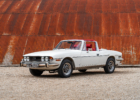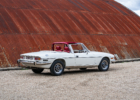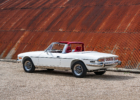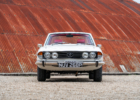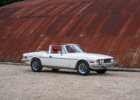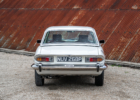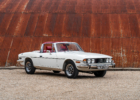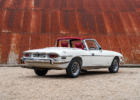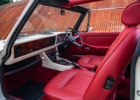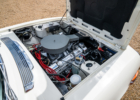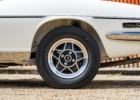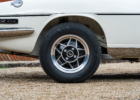1976 Triumph Stag Automatic
- Superbly restored by renowned specialist Stag Classics
- Rebuilt engine and automatic transmission
- A very versatile car that drives as superbly as it looks
- Matching hard-top and red folding roof in excellent condition
| YEAR | 1976 |
| MAKE | Triumph |
| PRICE | £28,500 |
VEHICLE DESCRIPTION
With its combination of sharp Italian styling, ‘2+2’ practicality and a sonorous V8 engine, it’s no wonder that the Triumph Stag continues to inspire a loyal following, and the example being offered for sale here must be one of the best in the UK.
This Stag was first registered on 23 June 1976, the penultimate year of production. As a late Series II model, it benefits from a number of improvements over earlier Stags and is still superbly presented following an extensive restoration.
The work was carried out by renowned specialist Paul McLaughlin at Stag Classics, and involved going right through the car with no expense spared. The suspension and braking systems were thoroughly overhauled, the engine was rebuilt, and all mechanical components were either replaced or comprehensively reconditioned.
The bodywork was restored and finished in Old English White, while the interior was fully retrimmed in red vinyl with contrasting white for the dashboard. A Kenwood DAB stereo was fitted, a new soft-top was installed, and the rear seats feature inertia-reel seatbelts.
A new hard-top was custom-made, and after the restoration was finished in around 2014, the car was used only sparingly and kept in a dehumidified garage.
The end result is a show-ready Triumph Stag that is beautifully presented throughout, drives superbly and comes with a comprehensive history file that’s full of invoices and receipts. The three-speed automatic gearbox is perfectly matched to the muscular 3-litre V8 engine, and whether it’s being enjoyed in top-down form or with the hard-top in place, this is a versatile and extremely usable example of this popular British classic.
MODEL HISTORY
The Triumph Stag can trace its roots to a styling experiment that Giovanni Michelotti produced for the 1966 Geneva Motor Show. The open-top car proved an immediate hit with Triumph management, who set about turning it into a production reality.
They investigated the use of a straight-six engine, but decided instead to produce a bespoke 3-litre V8 engine – despite the fact that Triumph became part of British Leyland during this time and therefore would have had access to the existing Buick-based V8.
The project’s codename was ‘Stag’, which survived all the way through to production, and the car was launched in May 1970. It featured independent suspension all round and a servo-assisted braking system comprising discs at the front and drums at the rear.
With one eye on the lucrative American market, the Stag was also well equipped, with power steering and electric windows. Buyers could choose between a four-speed manual gearbox with overdrive and a Borg-Warner three-speed automatic, and it featured a distinctive roll-over bar that was originally added not for safety but to bolster the roof-less monocoque structure.
The iron-block, alloy-head engine produced 145bhp at 5500rpm, which was enough to propel the car from 0-60mph in nine seconds and on to a top speed of almost 120mph. At just under £2000 when it was launched, it was also considerably cheaper than a Jaguar E-type or Mercedes 280SL – Triumph pitching it very much as an accessible alternative to those more exotic models.
An updated MkII version was introduced for 1973 with detail visual changes, a revised dashboard and seats, and a higher compression ratio for the V8 engine. Although it never sold in the numbers that Triumph expected, and production came to an end in 1977 after almost 26,000 had been produced, the Stag continues to be very well supported by specialists and owners’ clubs alike.


